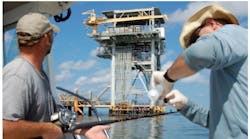Last year, when an explosion rocked the Deepwater Horizon oil rig in the Gulf of Mexico, the resulting oil spill lasted for three months. Extensive damage was suffered by both marine and wildlife habitats. Unfortunately, the risk to the Gulf remains high, as there are more than 20,000 abandoned and active gas and oil wells in the region. To check for potential leaks and spills, researchers at the Georgia Tech Research Institute (GTRI) are developing an advanced-warning system to detect the presence of oil in saltwater (see photo).
Traditionally, testing for oil contamination demands that samples be collected on site and brought back to a laboratory for analysis. In contrast, the GTRI sensor promises to remotely obtain direct, realtime measurements. To provide such capabilities, the surface of the sensor is coated with polymer films. These films are tailored to capture specific chemical compounds, such as the aromatic hydrocarbons that are present in oil. Using the interference of light waves (i.e., interferometry), the sensor can determine how muchif anyoil is present in a water sample.
Essentially, light from a laser diode is coupled into an optical waveguide through a grating. It travels along the two channels comprising the interferometer. One channel interacts with the sensing film while the other serves as a reference. That reference channel minimizes the response of any non-specific interactions, such as temperature and mechanical motion. By using appropriate polymer combinations, the researchers can selectively detect oil compounds in a mixture of chemicals that may be present in a water sample.
At the end of the waveguide, the light beams from the sensing and reference channels are combined to create an interference pattern. The pattern of alternating dark and light vertical stripes, or "fringes," is imaged on a simple charge-coupled-device (CCD) detector. By performing a Fast Fourier Transform (FFT) calculation, the researchers can determine the degree to which the fringe patterns are in or out of step with each other. Known as phase shift, this aspect indicates the amount of oil captured on the film.
GTRI Senior Research Scientists John Devitt, Kevin Caravati, and Ray Doylewith the help of Graduate Research Assistant Joel Keelorhave tested the device on oil and water samples. They collected those samples from waters off the Mississippi and Louisiana coasts last September after the explosion of the Deepwater Horizon rig. Initial results indicate that the sensor is able to detect oil constituents and breakdown products from the samples. With funding support from GTRI's Independent Research and Development program, the research team will continue to improve the sensor's coating chemistry and hopes to deploy the sensor for further testing in the Gulf of Mexico sometime this year.
Once this sensor system is operational, digital signals could be wirelessly transmitted to officials when oil or its breakdown compounds are detected. The resulting alarm would alert them to the type of toxicity and location of the incident, facilitating an immediate and appropriate response. The system's design makes it easy to integrate into a low-cost, low-maintenance, scalable package that can run on battery or solar power.
